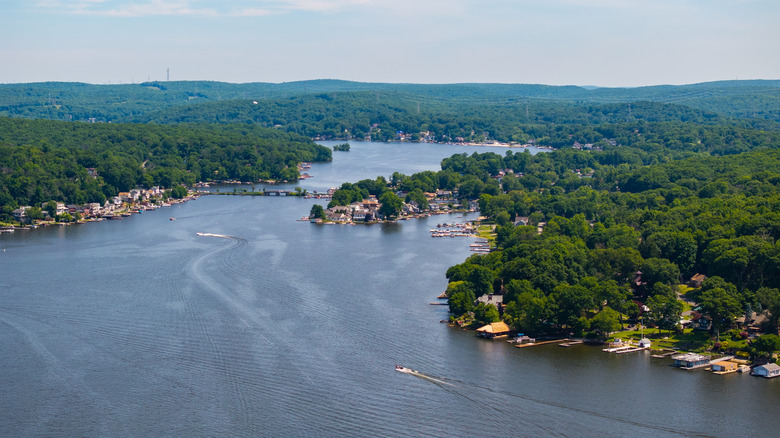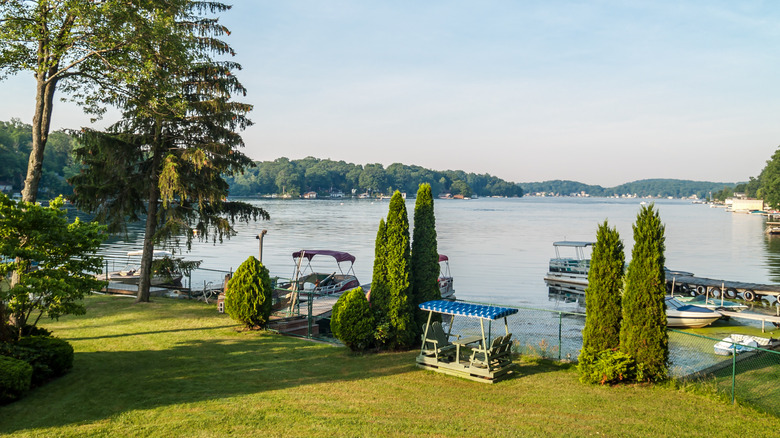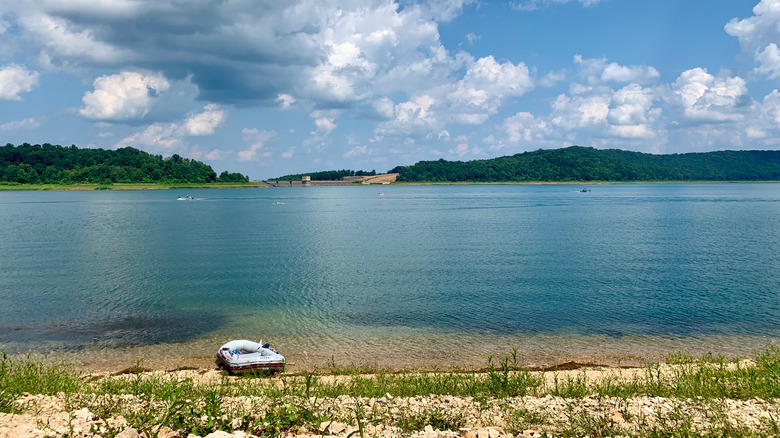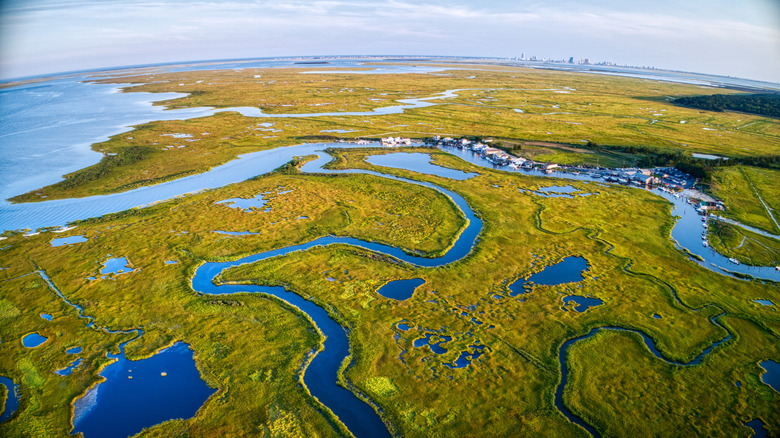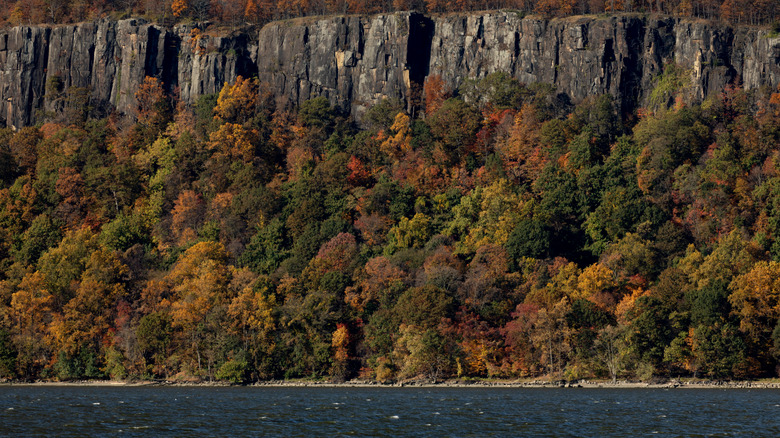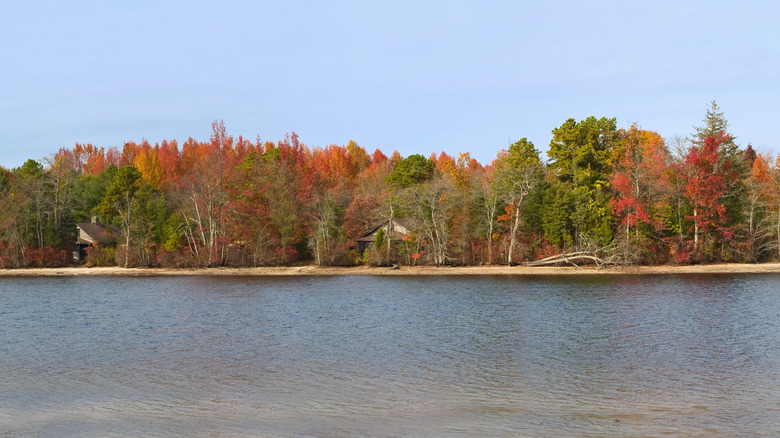The Most Snake-Filled Lakes And Rivers In New Jersey You'll Want To Know About Before You Swim
Summer is here, and getting out in nature means sharing the outdoors with the wildlife that calls it home. That includes snakes. New Jersey might not be the first place that comes to mind when you think of snake territory, but the state's lakes, rivers, and wetlands host a surprising number of aquatic and semi-acquatic serpents. Knowing what to expect before you dive in can help you (and the state's snakes) stay safe.
First things first: Of the 22 snake species that currently live in New Jersey, only two are venomous: the Northern copperhead and the timber rattlesnake and neither is particularly common. Beyond that, you've got a mix of relatively harmless green snakes, Northern water snakes, ringnecks, garters, and more. These snakes aren't limited to backwoods swamps, either. They frequent some of the state's most popular lakes and rivers, especially in summer when they bask on rocks or hunt fish and amphibians near the shoreline.
As we pointed out in our piece on Washington's most snake-filled lakes and rivers, snakes get a lot of unwarranted hate. Understanding their nature is another way to avoid an unpleasant run-in with one. Instead of the hissing, aggressive fiends that pop culture often depicts them as, snakes are just reptiles looking for food, warmth, and cover. Bites are rare and typically occur only when a snake feels cornered or threatened.. That said, some bodies of water in New Jersey are more known for their snake presence than others. So, if you're planning on spending any time swimming, fishing, or kayaking in New Jersey this season, here's a list of five locations where keeping your head on a swivel will help keep your day a snake-free one.
New Jersey's biggest lake: Lake Hopatcong
As New Jersey's largest lake, Lake Hopatcong is a magnet for summer recreation. Visitors flock here for boating, swimming, paddleboarding, and waterfront hiking in the warmer months, but the lake's warm shallows and thick shoreline vegetation make it just as attractive to snakes. The Northern water snake is one of the most common in the state, and Lake Hopatcong is no exception. While it's non-venomous, it's often confused with the venomous Northern copperhead due to its brown color and broad reddish-black bands covering its back and neck.
These snakes are often spotted sunning themselves on rocks near still or slow-moving water. They are highly capable swimmers and, as such, dine heavily on amphibians and fish. If a Northern water snake feels threatened, it may flatten its body and strike, delivering a painful bite. Though non-venomous, the snake has a sharp set of teeth and an anticoagulant in its saliva, meaning bites tend to result in a bloodier wound than you might expect. To avoid an encounter, steer clear of splashing near dense vegetation or climbing through brushy areas along the lakefront. The snake's normal response to seeing a human is to swim or slither away.
There's no need to cancel your day out on the lake, but being aware of your surroundings goes a long way. Watch where you step while wading if you're going paddleboarding or kayaking, and inspect any picnic areas before settling in. Hikers on the nearby Lake Hopatcong Trail should also be vigilant when passing through wooded or marshy areas. There are plenty of ways to have fun on Lake Hopatcong, and staying alert and respectful of the animals that call it home is the best way to do that.
Round Valley Reservoir
The Round Valley Reservoir is part of the Round Valley Recreation Area located in Northern New Jersey, covering an impressive 2,350 acres and holding 55 billion gallons of water. Its size and depth make it a popular destination for boating and fishing, and its clear blue waters draw snorkelers and scuba divers from miles around. The reservoir's wooded slopes and grassy shoreline also provide habitat for several snake species.
The reservoir sits within the geographic ranges of both the timber rattlesnake and the Northern copperhead, New Jersey's only two venomous snakes. That sounds scarier than it is. Between 1999 and 2023, only 16 cases of venomous bites were reported in the state, and there have been zero recorded fatalities from either species. Still, it's good to know what to look for. The timber rattlesnake is generally gray, brown, or yellow, accented by black or dark brown markings, and likes to frequent rocky, wooded areas, river floodplains, and swamps. If you're near the woods, scan the branches of the trees. Timber rattlers are great climbers and have been spotted in canopies up to 80 feet high. Northern copperheads, on the other hand, are a distinct copper-red and browns, lack markings on their wide, triangle-shaped head, and feature hourglass-shaped bands on their bodies.
For a safe visit, wear closed-toed shoes around boat launches and trailheads and steer clear of rocky outcrops and brushy edges. If you're venturing along the shoreline, remain alert, especially during mid-summer days when snakes sun on exposed rocks. Swimming is only allowed at the reservoir's designated beach area, but if you happen to find yourself in the water by any boat ramps or other parts of the shoreline, keep your head on a swivel and give any snakes you see a wide berth for your safety and theirs.
The Mullica River and surrounding territory
The Mullica River winds through New Jersey's Pine Barrens, a heavily forested ecosystem in the Southern part of the state that spans over a million acres. Starting from its headwaters in Camden County and flowing out to Great Bay, the river's relatively shallow depths and sandy, forested banks make it a favorite among kayakers, anglers, and wildlife photographers. It's also the perfect habitat for numerous snake species, including Eastern kingsnakes, ribbon snakes, Northern pine snakes, and more.
One notable species that lives here is the Northern pine snake, a threatened species that favors sandy habitats for burrowing underground. True to its name, though, the Northern pine snake is an adept tree climber when it needs to be. The snake can grow to a length of anywhere from 50 to 100 inches and features grayish-white coloration marked by brownish-black blotches that get more distinct towards its tail. If you spot one, don't approach; this snake can deliver a powerful and painful bite when threatened, even though it's non-venomous.
Canoeists and kayakers in particular should be aware of their surroundings while near and on the river. The watery trails that run through this forested wetland environment are abundant with undergrowth that's ideal for snake shelter and hunting. Your odds of a snake encounter rise in the river's more secluded areas near Sweetwater or the Wharton State Forest, but that doesn't mean you won't find them elsewhere along its path to the ocean. Hikers along the Mullica River Trail should also be aware of the fact that they're in snake country, and that anywhere along its 9.5-mile length is fair game for a sighting.
The Hudson River
The Hudson River marks New Jersey's northeastern border, and the river features a few outdoor activity hotspots along its length. One of the most frequented is the Palisades Interstate Park, a hiking paradise of Hudson River vistas and pristine winding trails near New York, comprising a 12-mile stretch of shoreline that hosts 2,500 acres of cliffs and scenic lookouts.
The park serves as a refuge for wildlife as much as it does for individuals seeking a brief escape from the city into nature. A mix of Northern ringneck snakes and Eastern milk snakes have been known to inhabit the park, and even the venomous Eastern copperhead has been spotted here. However, you're more likely to come across small, run-of-the-mill garter snakes and the significantly larger (but mostly harmless) black rat snake. This snake's size (it can grow to over 100 inches in length) and plain black coloring make it easy to identify and distinguish from the more colorful and venomous timber rattlesnake, which can be seen swimming in the Hudson's waters on occasion. The black rat snake can climb trees and likes to hang out in rocky nooks and stone walls. It's also been known to hang around dumpsters and trash piles hunting for rodents.
Unfortunately, black rat snakes are often the recipient of unwarranted discrimination due to their startling size. But like all snakes, this one plays a vital role in local ecosystems. In New Jersey's Hudson River area, they help ensure rodent populations don't get out of hand. So, even if you're not a fan of snakes, just remember that there would be a lot more rats and other critters without them.
Atsion Lake
Atsion Lake is a relatively small body of water in Wharton State Forest accessible through the Atsion Recreation Area. The gorgeous, tree-lined lake is a magnet for kayaking, swimming, picnicking, and camping. Wildlife photographers are drawn to the lake for its abundance of birds (including red-tailed hawks, great blue herons, and bald eagles), turtles, and amphibians. Nine rustic cabins line the lake as well, which make for excellent outdoor stays, especially in the fall when the trees turn color.
Because it's located in New Jersey's mysterious, wooded region of abandoned towns that is the Pine Barrens, know that you're sharing this landscape with the local wildlife. The Northern water snake is the most common inhabitant here, often seen basking on warm rocks and logs or hunting in brush and undergrowth for fish and frogs. Fun fact about these snakes: They can dive underwater to escape danger and even hook themselves to submerged logs or rocks, and are even capable of staying there for up to 90 minutes. Other snakes to watch out for are the venomous timber rattlesnake and the non-venomous Eastern kingsnake.
The Eastern kingsnake is gray-black in color, with thin white or cream-colored stripes that resemble a chain-link fence. You'll usually find them under logs or rocky areas near the water. Like the black rat snake, the Eastern kingsnake often receives unwarranted discrimination due to its size. But this species isn't just effective at keeping rodent populations in check; it also preys on other snake species, including venomous ones. So, whatever your outdoor plans are in New Jersey this summer, keeping a respectful eye out for the state's natural inhabitants is the best way to guarantee those plans don't go awry.
